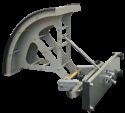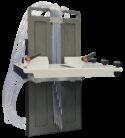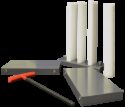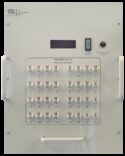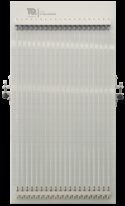Base Unit
FC300-7.5
7.5 x 0.3 x 0.45 Metre Flume
A 300 mm wide, 5 to 15 m long flume for student study and advanced research into a wide range of fluid flow topics. A huge range of ancillaries are available to extend learning potential and offers the opportunity for innovative experimentation.
If you have any questions or you'd like to discuss a product, please call us.
+44 1159 722 6117.5 x 0.3 x 0.45 Metre Flume
The FC300 Series channels are 300 mm in width, 450 mm in height, and are available in 5 metre, 7.5 metre, 10 metre, 12.5 metre and 15 metre lengths.
The flumes have various models available, giving students a wide choice of experimentation in open channel flow.
The flumes have a built-in re-circulating water supply connected to a digital flow metre for accurate measurements during experimentation.
The flumes have pressure measurement tappings at 0.25 metre intervals along the working section. These tappings can connect either to a multi-tube manometer or to a 32-way pressure display. The 32-way pressure display connects to TecQuipment’s VDAS® for real-time data acquisition.
Each FC300 is supplied with two level gauges (hook and point) and a Pitot tube, all of which mount onto and run along the instrument rails at the top of the flume. Measurements from these instruments combined with the digital flow meter provide the potential for extensive analysis of open channel flow for research or advanced study.
Bed-load transport can be investigated using the optional Sediment Loop (FC300sl). This ancillary provides a closed sediment circuit consisting of a sediment trap and feed mechanism which allows sand to be pumped from the trap to a feeder located above the working section between experiments.
The flume is made of transparent glass, precision-built to ensure parallel walls and a consistently accurate cross-section along its length. A sturdy steel
square-section firmly supports the channel throughout its length. It has a floor-standing frame that supports the working section at a convenient eye-level position for students.
Screw jacks raise and lower the supports inclining the channel as required. The digital inclinometer gives an accurate display of the channel angle.
A pump with a speed controller, forces water up to the flow settling chamber at the upstream end of the channel. This gives smooth, uniform flow, free from entry effects.
Learning outcomes
- Sluice gate for investigations into hydraulic jump, specific energy and the determination of discharge coefficient
- Submerged sharp-crested weir reveals the relationship between head over a weir and discharge
- A broad-crested weir and the effects of changing the profile of the weir (optional ancillary)
- Uniform flow in an inclined channel with investigations into the Chezy factor and coefficient
- A Venturi flume to indicate the discharge and surface profile, thus the derivation of the discharge coefficient
- Further experimentation with additional optional models
- With the optional Sediment Loop (FC300sl) and included permeable medium, sediment transport, scouring, ripple and dune formation and similar studies can be performed










